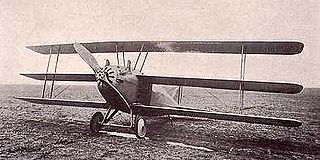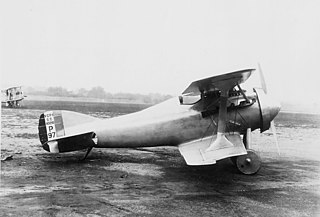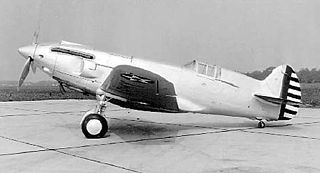
The Curtiss A-8 was a low-wing monoplane ground-attack aircraft built by the United States company Curtiss Aeroplane and Motor Company, designed in response to a 1929 United States Army Air Corps requirement for an attack aircraft to replace the A-3 Falcon. The Model 59 "Shrike" was designated XA-8.

A triplane is a fixed-wing aircraft equipped with three vertically stacked wing planes. Tailplanes and canard foreplanes are not normally included in this count, although they may be occasionally.

The Curtiss SC Seahawk was a scout seaplane designed by the Curtiss Aeroplane and Motor Company for the United States Navy. The existing Curtiss SO3C Seamew and Vought OS2U Kingfisher were gradually replaced with the Seahawk in the late stages of the war and into peacetime.

The Curtiss F6C Hawk was a late 1920s American naval biplane fighter aircraft. It was part of the long line of Curtiss Hawk airplanes built by the Curtiss Aeroplane and Motor Company for the American military.

The Curtiss 18T, unofficially known as the Wasp and by the United States Navy as the Kirkham, was an early American triplane fighter aircraft designed by Curtiss for the US Navy.

The Curtiss R3C was an American racing aircraft built in landplane and floatplane form. It was a single-seat biplane built by the Curtiss Aeroplane and Motor Company.

The Curtiss CR was a racing aircraft designed for the United States Navy in 1921 by Curtiss. It was a conventional single-seater biplane with a monocoque fuselage and staggered single-bay wings of equal span braced with N-struts. Two essentially similar landplane versions were built as the CR-1 and CR-2, which were both eventually converted to seaplanes as the CR-3 in 1923 and CR-4 in 1924. A refined version was developed for the US Army Air Service under the designation R-6. These latter two aircraft featured refined aerodynamics included surface-mounted radiators.

The Curtiss R2C was a racing aircraft designed for the United States Navy in 1923 by Curtiss. It was a single-seater biplane with a monocoque fuselage and staggered single-bay wings of unequal span braced with I-struts. The aircraft's advanced streamlining featured a top wing mounted directly to the top of the fuselage and surface-mounted radiators for cooling the engine. The aircraft was originally designed and built as a landplane under the Navy designation R2C-1, of which two examples were produced. One was converted into a seaplane version known as the R2C-2 the following year.

The Curtiss Model 54 Tanager was an aircraft constructed in 1929 as Curtiss' entry in the Guggenheim Safe Aircraft Competition.

The Curtiss-Wright CW-1 Junior, originally named the Curtiss-Robertson CR-1 Skeeter is a light sports aircraft produced in the United States in the 1930s. It had been intended to sell it for the price of a mid-range automobile.

The Curtiss Model R was a utility aircraft produced for the United States Army and Navy during World War I. It was a conventional, two-bay biplane with slightly staggered wings of unequal span. The aircraft was provided with two open cockpits in tandem and fixed tailskid undercarriage, but many were built for the Navy with twin floats replacing the wheels. During the course of the war, Model Rs were used for general liaison and communication duties, as well for observation, training, and as air ambulances. In practice, the Curtiss powerplants supplied with these aircraft proved insufficient and were mostly replaced with Liberty engines. The Navy's Model R-3 floatplane had extended-span, three-bay wings, and was intended for use as a torpedo bomber. Some of these were later fitted with wheeled undercarriage and transferred to the Army as bombers under the designation Model R-9.

The Fokker F.II was the first of a long series of commercial aircraft from the Fokker Aircraft Company, flying in 1919. In a biplane age, it presented a distinct clean, high-wing monoplane style that sold successfully across Europe and North America during the development of commercial passenger-carrying aviation.

The Verville VCP was an American single-engined biplane fighter aircraft of the 1920s. A single example of the VCP-1 was built by the United States Army Air Service's Engineering Division, which was later rebuilt into a successful racing aircraft, while a second, modified fighter was built as the PW-1.

The Curtiss O-40 Raven was an American observation aircraft of the 1930s which was built and used in small numbers. A single example of the YO-40, a single-engined Sesquiplane with a retractable undercarriage was built, followed by four examples of a modified monoplane version, the O-40B, which remained in use until 1939.

The Curtiss C-1 Canada was a twin-engined bomber aircraft of the First World War which was designed by Curtiss of America to be built by their Canadian subsidiary for the British Royal Naval Air Service and Royal Flying Corps. Although large orders were placed, only twelve were built, the type being rejected in favour of more capable aircraft such as the Handley Page O/100.

The Curtiss P-37 was a fighter aircraft made by Curtiss-Wright in 1937. A development of the Curtiss P-36 Hawk, the P-37 never entered production.

The Thomas-Morse R-5 also known as the TM-22 was an American single-engined parasol monoplane racing aircraft of the 1920s. Two were built for the United States Army Air Service in 1922, but after competing in the 1922 Pulitzer Trophy Race the type was abandoned.

The sole Granville Gee Bee R-6 International Super Sportster, named "Q.E.D." Quod Erat Demonstrandum, and later named "Conquistador del Cielo", was the last in a series of racing and touring monoplane aircraft from the Granville Brothers. The R-6H was dogged with bad luck throughout its career and had the unfortunate distinction of never finishing any race it entered.
The Driggs-Johnson DJ-1 Bumblebee was a single engine, low power, single seat, parasol wing sports monoplane built in the US in 1924. It and its immediate development the Driggs Dart 1 had some competition successes; the design was further developed into two seat sesquiplanes known as the Driggs Dart 2 and Skylark. In all, about twenty were built.
The Emsco B-4 Cirrus was a mid-wing, two-seat trainer built in the US in the late 1920s. Six were built and three variants with more powerful engines flown.



















